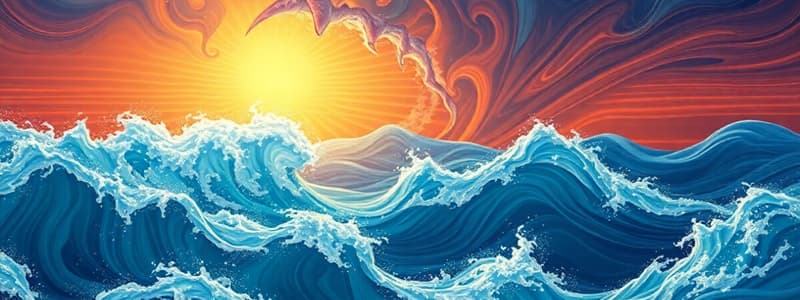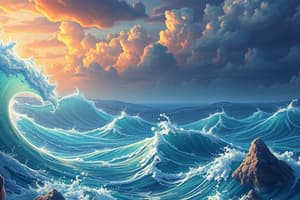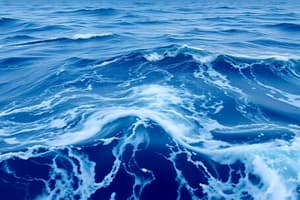Podcast
Questions and Answers
Which factor is LEAST influential in the westward intensification of ocean currents, as explained by Stommel's 1948 paper?
Which factor is LEAST influential in the westward intensification of ocean currents, as explained by Stommel's 1948 paper?
- The Coriolis effect
- Fluid dynamics
- Differential solar heating (correct)
- The Earth's curvature
How did Stommel's research significantly broaden the understanding of ocean dynamics?
How did Stommel's research significantly broaden the understanding of ocean dynamics?
- By introducing a comprehensive analysis of small-scale turbulence in coastal regions.
- By pioneering the study of the dynamics of large-scale ocean circulation, including the Gulf Stream's position and intensity. (correct)
- By explaining the role of deep-sea trenches in creating upwelling zones.
- By primarily focusing on the chemical composition of seawater and its effects on marine life.
What is the primary driving force behind deep-ocean circulation, according to the theories developed by Stommel and his colleagues?
What is the primary driving force behind deep-ocean circulation, according to the theories developed by Stommel and his colleagues?
- Tidal forces exerted by the moon and sun
- Geothermal vents on the ocean floor causing localized convection
- Wind-driven surface currents
- Thermohaline effects related to temperature and salinity (correct)
What key process initiates the 'conveyor belt' effect in global ocean circulation, as described by Stommel's theory of thermohaline circulation?
What key process initiates the 'conveyor belt' effect in global ocean circulation, as described by Stommel's theory of thermohaline circulation?
What was the primary purpose of the PANULIRUS research station established in Bermuda?
What was the primary purpose of the PANULIRUS research station established in Bermuda?
Which of the following best captures the integrated focus of Stommel's research that led to a comprehensive understanding of ocean circulation?
Which of the following best captures the integrated focus of Stommel's research that led to a comprehensive understanding of ocean circulation?
What does Stommel's work suggest about the relationship between surface and deep-ocean currents?
What does Stommel's work suggest about the relationship between surface and deep-ocean currents?
Consider the implications if the thermohaline circulation were to slow down significantly due to climate change. What far-reaching effect is most likely?
Consider the implications if the thermohaline circulation were to slow down significantly due to climate change. What far-reaching effect is most likely?
Flashcards
Henry Stommel
Henry Stommel
Oceanographer who transformed the field and explained forces driving ocean currents like the Gulf Stream.
Coriolis effect
Coriolis effect
A phenomenon where moving objects are deflected due to Earth's rotation, influencing ocean currents.
Westward intensification
Westward intensification
Explains stronger currents on the western sides of ocean basins due to fluid dynamics and Earth's rotation.
Gulf Stream
Gulf Stream
Signup and view all the flashcards
Thermohaline circulation
Thermohaline circulation
Signup and view all the flashcards
Global ocean circulation
Global ocean circulation
Signup and view all the flashcards
Sea ice formation effect
Sea ice formation effect
Signup and view all the flashcards
Great Ocean Conveyor Belt
Great Ocean Conveyor Belt
Signup and view all the flashcards
Study Notes
- Henry Stommel transformed oceanography into a major scientific field.
- He explained the forces that drive ocean currents, including the Gulf Stream.
- Stommel studied astronomy at Yale University and taught there for two years.
- In 1944, he joined the Woods Hole Oceanographic Institution (WHOI).
- Stommel later held oceanography posts at Harvard and MIT.
- He eventually returned to WHOI.
Fluid Dynamics
- In 1948, Stommel's paper explained the westward intensification of wind-driven ocean currents.
- The paper showed how fluid dynamics, Earth's curvature, and the Coriolis effect cause stronger currents on the western boundaries of ocean basins.
- Stommel's solution explained the position and intensity of the Gulf Stream.
- This opened a new area of study, the dynamics of large-scale ocean circulation.
Thermohaline Effects
- Stommel and colleagues developed a theory of global ocean circulation with their work on thermohaline effects.
- When sea ice forms, seawater becomes saltier and denser, sinking and pulling in warmer water.
- This creates a conveyor belt of moving water through the world's oceans.
- Surface currents are wind-driven, while thermohaline forces drive deep-ocean circulation.
Research and Recognition
- In 1954, Stommel set up the PANULIRUS research station in Bermuda to gather extensive ocean data.
- He published "The Gulf Stream" in 1958, after studying the current's global context for a decade.
- In 1959, he became a professor of oceanography at Harvard.
- Stommel oversaw two successful global studies of ocean processes.
- He was awarded the United States National Medal of Science in 1989 for his work on ocean currents.
Studying That Suits You
Use AI to generate personalized quizzes and flashcards to suit your learning preferences.






